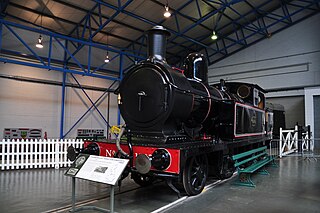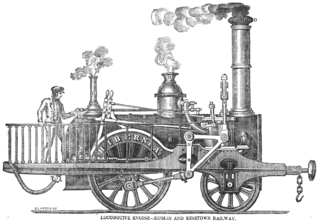Related Research Articles

The Lancashire and Yorkshire Railway Class 5 were 2-4-2T steam locomotives designed by Chief Mechanical Engineer (CME) John Aspinall and introduced from 1889 for local passenger work. Later batches included progressive modifications such as extended coal bunkers and Belpaire fireboxes. The final batch built from 1911 to 1914 under George Hughes incorporating superheated boilers gave increased tractive effort, others were also rebuilt to this standard. When Hughes introduced his classification system in 1919, the more powerful superheated locomotives were designated Class 6. The final examples were withdrawn in 1961.

Under the Whyte notation for the classification of steam locomotives, 0-8-4 represents the wheel arrangement of no leading wheels, eight powered and coupled driving wheels on four axles, and four trailing wheels on two axles.

The Dublin and Kingstown Railway (D&KR), which opened in 1834, was Ireland's first passenger railway. It linked Westland Row in Dublin with Kingstown Harbour in County Dublin.

The GS&WR Class 101, classified as Class 101 or Class J15 by the Great Southern Railways, was a class of 0-6-0 steam locomotives designed for working goods traffic although they did, and were quite capable of, working branch and secondary passenger trains.

The Midland Great Western Railway (MGWR) A Class, later Inchicore Class D5, consisted of 6 4-4-0 express passenger locomotives built at Broadstone Works in the period 1902-1905. The largest express passenger locomotive in Ireland for a short while after introduction they were used on the MGWR's flagship services to Galway with most surviving until the 1950s albeit on less prestigious work.
The Great Southern Railways (GSR) Class 700 consisted of five 0-6-0 locomotives built by Inchicore railway works in 1929 and were the last locomotives designed by J. R. Bazin. The Class 710 consisted of ten 0-6-0 locomotives built by Inchicore railway works in 1934.
The Great Southern and Western Railway (GS&WR) Class 900 consisted of a pair of 4-8-0T locomotives designed by E.A. Watson and introduced in 1915 and 1924 as a heavy shunter and banker for use on the relatively severe gradient from Kingsbridge to Clondalkin.
The Great Southern and Western Railway (GS&WR) Class 351 initially consisted of four 0-6-0 tender locomotives designed by Robert Coey for use on heavy freight trains on the main line. They were joined by four similar locomotives built in 1912 introduced by Richard Maunsell, these had detail differences such as larger cabs and higher running plates. They included an extended smokebox to which a Phoenix superheater was briefly trialed but abandoned. They were initially designated GS&WR Class 249 but were subsequently grouped into class 351.

The Great Southern and Western Railway (GS&WR) Class 368 consisted of four 2-6-0 tender locomotives designed by Robert Coey for use on heavy freight trains. on the main line.

The DSER 20 class was a class of three 4-4-2T locomotives operated by the Dublin and South Eastern Railway and later the Great Southern Railways and CIÉ.
Dublin, Wicklow and Wexford Railway (DW&WR) 52 to 54 were a class of three 4-4-2T locomotives designed by William Wakefield for Kingstown Pier to Kingsbridge boat trains. At one point they carried the names Duke of Connaught, Duke of Abercorn and Duke of Leinster respectively.
Dublin, Wicklow and Wexford Railway (DW&WR) 11 built in 1896 was the predecessor to a total of twelve 2-4-2T locomotives to emerge from Grand Canal Street railway works between 1896 and 1910. Eleven of twelve lasted through to the early 1950s, the only loss being due to the Civil war, and despite attempts to replace them remained they remained vital to the running of the South Dublin services suburban services to Bray throughout their lives.
The Dublin, Wicklow and Wexford Railway (DW&WR) 2, built in 1885, was the predecessor to a total of eleven 2-4-0T locomotives to emerge from Grand Canal Street railway works between 1885 and 1896.
Dublin, Wicklow and Wexford Railway (DW&WR) 24 was the lead engine of a class of five 2-4-0 tender locomotives built in two batches in 1864 and 1873.
Dublin, Wicklow and Wexford Railway (DW&WR) 13 was an 0-6-0 goods locomotive built in 1904 at Grand Canal Street railway works and was followed by four more of the same class, two being contracted to Beyer, Peacock and Company.

Dublin, Wicklow and Wexford Railway (DW&WR) 55 to 58 were 4-4-0 locomotives built from 1895 at Vulcan Foundry for express passenger duties on the Dublin—Wexford mainline. They were to remain the DW&WR's and subsequent Dublin and South Eastern Railway's leading express passenger locomotive until the arrival of Nos. 67 and 68 some ten years later.
Dublin, Wicklow and Wexford Railway (DW&WR) 50 and 51 were two 0-6-0 tender locomotives built in 1891 at Vulcan Works and were named Arklow and New Ross respectively. These were the first the 0-6-0 wheel configuration to be purchased by the DW&WR. The DW&WR's own Grand Canal Street were to construct two more in 1899/1900 and to follow that with a design for five more from 1904. The DW&WR became the Dublin and South Eastern Railway (DSER) from the end of 1906. Under the locomotive engineer R. Cronin both engines were rebuilt with Belpaire boilers in 1912 and 1915 respectively and the boiler pressure increased to 160 lb.
The Dublin, Wicklow and Wexford Railway (DW&WR) Ariel Class refers to seven 2-2-2WT well tank locomotives built by Neilson and Company and introduced in 1865.

The Great Southern and Western Railway (GS&WR) Class 37 consisted of six 4-4-2T tank engines. The first two built by locomotive superintendent Henry Ivatt (Snr.) were based on a previous 2-4-0T design by McDonnell, as were some 2-4-2Ts Ivatt produced two years earlier for the Kerry branches.
The Lancashire and Yorkshire Railway (L&YR) Barton Wright 0-6-2T were tank engines introduced by Barton Wright between 1877 and 1883. This was the first use of the 0-6-2T type in Britain.
References
Notes
- ↑ Shepherd and Beesley comment that for most companies who combined these roles the result was generally not successful. [4]
- ↑ This was different from more conventional thinking that tank engines are generally better for short trips, suburban and branch line work while tender engines are better suited to longer main line trips with their higher water capacity and possibly better running at speed
- ↑ Ahrons indicated he had no idea what purpose these particular pair of engines were ordered for. [2]
- ↑ A follow on batch of 15 were diverted to the Hull and Barnsley Railway in 1899 as Class F1 due to non-payment issues
- ↑ Being the single member of class and therefore non-standard would have been a factor in consideration of withdrawal
Footnotes
- 1 2 Boocock (2009), p. 41.
- 1 2 Ahrons (1954), pp. 48, 49.
- 1 2 3 4 5 6 Clements & McMahon (2008), pp. 129–132, 144.
- 1 2 3 4 5 6 7 8 9 Shepherd & Beesley (1998), pp. 86–87.
- ↑ Shepherd & Beesley (1998), pp. 86.
Sources
- Ahrons, E. L. (1954). L. L. Asher (ed.). Locomotive and train working in the latter part of the nineteenth century. Vol. six. W Heffer & Sons Ltd. OCLC 606019549. OL 21457769M.
- Boocock, Colin (1 October 2009). Locomotive Compendium Ireland (1st ed.). Hersham: Ian Allan. ISBN 9780711033603. OCLC 423592044.
- Clements, Jeremy; McMahon, Michael (2008). Locomotives of the GSR. Newtownards: Colourpoint Books. ISBN 9781906578268. OCLC 547074718.
- Shepherd, Ernie; Beesley, Gerry (1998) [1974]. The Dublin & South Eastern Railway : an illustrated history. Leicester: Midland. ISBN 9781857800821. OCLC 60215087.